Seven Impossible Interviews
Before Breakfast #84: Joyce Sidman
(And an Early Poetry Friday Treat)
 April 1st, 2010 by jules
April 1st, 2010 by jules
You’d think I would have timed today’s interview with children’s poet Joyce Sidman, pictured here in her happy place, to mark the very first day of National Poetry Month 2010. But, no sirree, I’m simply not that organized. But what good timing, as Joyce is one of the country’s most talented children’s poets and has brought us some excellent picture books. (Or, if you want the professional’s opinion: “Her skill as a poet accessible to young people is unmatched.” And that would be School Library Journal.) And, though I can’t claim any master organization on my part on this first official day of a month-long poetry celebration, I’ve very simply always wanted to chat with Joyce, have her over to the 7-Imp ranch (it was the 7-Imp bungalow on Tuesday; I’m feeling more expansive today) to talk about her work.
Joyce also has a brand-new poetry collection out, illustrated by Beckie Prange and released by Houghton Mifflin this month, titled Ubiquitous: Celebrating Nature’s Survivors. It’s everything I expect from a poetry-meets-science Joyce-Sidman title: The evocative poetry, at its heart, celebrates life; honors its mysteries; and gently nudges readers to open their eyes already to our always beautiful, but oft-ignored, natural world. “Sidman’s words are vivid and affectionate,” writes Publishers Weekly about the new book, which—as the sub-title tells you—celebrates the biologically prosperous species of the world. “Sidman delights with another gorgeous collection of poems,” adds Kirkus.
The book is arranged in the chronological order by which these survivors of nature appeared on Earth, opening with striking endpapers depicting each species on a lengthy, serpentine timeline. Here is, arguably, my favorite spread with its lovely—if not, sharp-toothed—moment of concrete poetry. Yes, it’s “arguably” my favorite. Don’t make me choose.
A lovely book. Visually striking. Beautifully designed. And not just graced with Joyce’s poetry — but also filled with nonfiction facts about the species showcased on each spread.
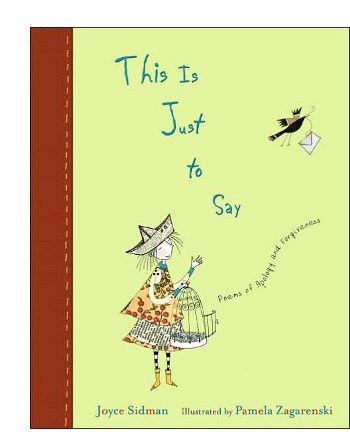 And this isn’t Joyce’s first collaboration with woodcut artist and naturalist Beckie Prange. Song of the Water Boatman & Other Pond Poems (Houghton Mifflin, 2005) was their first title together, for which Beckie was awarded a 2006 Caldecott Honor. Early this year, Joyce’s Red Sings From Treetops (Houghton Mifflin, 2009), illustrated by Pamela Zagarenski (who visited me for breakfast in June of last year), was also awarded a Caldecott Honor. Joyce has released an exuberant collection of concrete poetry; a beautiful look at what’s in a meadow (“Combining striking illustrations, evocative poems that do double duty as riddles and lucid prose commentary, this venture into the natural world stands out for both its beauty and its unusual approach,” wrote Kirkus); a series of apology poems (pictured above), probably my favorite collection of all, both touching and funny, which School Library Journal named their Best Book of the Year and which was awarded the Claudia Lewis Poetry Award from the Banks Street College of New York; and more. (You can read about all of Joyce’s books here at her site’s bookshelf.)
And this isn’t Joyce’s first collaboration with woodcut artist and naturalist Beckie Prange. Song of the Water Boatman & Other Pond Poems (Houghton Mifflin, 2005) was their first title together, for which Beckie was awarded a 2006 Caldecott Honor. Early this year, Joyce’s Red Sings From Treetops (Houghton Mifflin, 2009), illustrated by Pamela Zagarenski (who visited me for breakfast in June of last year), was also awarded a Caldecott Honor. Joyce has released an exuberant collection of concrete poetry; a beautiful look at what’s in a meadow (“Combining striking illustrations, evocative poems that do double duty as riddles and lucid prose commentary, this venture into the natural world stands out for both its beauty and its unusual approach,” wrote Kirkus); a series of apology poems (pictured above), probably my favorite collection of all, both touching and funny, which School Library Journal named their Best Book of the Year and which was awarded the Claudia Lewis Poetry Award from the Banks Street College of New York; and more. (You can read about all of Joyce’s books here at her site’s bookshelf.)
Needless to say, it’s an honor to have Joyce here this morning to help me kick off National Poetry Month — even if it was a happy accident on my part. I chatted with her about this new title, her work in schools, what’s next for her, and much more. I thank her for stopping by.
7-Imp: Can you talk about the genesis of Ubiquitous? It’s a really beautiful book. Did you have a say in Beckie Prange as the choice of illustrator?
Joyce: The book began with a conversation with my biologist sister, to whom the book is dedicated. She was pointing out to me that the beetle on her palm was a prolific organism because of a successful mutation long ago that had hardened its forewings into something resembling armor. This started me thinking about why some organisms thrive while others die out.
The book was a fascinating journey. Long. Full of research. It strained my brain. But I learned so much. Yes, my editor conferred with me before asking Beckie to illustrate it. Of course I said yes! Beckie was the perfect person, because of her biology background—she has a degree in scientific illustration and cares so deeply about the natural world. I went to visit her while she was working on this project, and she gleefully showed me a 20-lb. encyclopedia of lichens she was consulting.
7-Imp: Can you also tell me a bit about the genesis behind Red Sings From Treetops: A Year in Colors? How did the idea for this come to you? Tell me about the Big Call, too – the moment you found out about the Caldecott Honor.
Joyce: I’d been thinking about color for a long, long time. Color gives me such joy, and so do the seasons. I’d always loved Hailstones and Halibut Bones (O’Neill) and dreamed of writing something that mixed up the senses like that book. It took me a couple years of walking in the woods muttering to myself to get it right, though.
The Big Call: Well, authors of Caldecott books don’t get THE call (from the committee), but I got a wonderful call from my editor Ann Rider as I was preparing to watch the ALA news conference online. “Joyce,” she said, “you know there’s only one reason I’d be calling you at 7:30 in the morning . . .”
7-Imp: What was it like to see Pamela’s art for this title – for the first time?
Joyce: Wow. Many illustrators use a text to create their own world, but Pamela created a whole universe with Red Sings. The crowns! The wheels! The mysterious windows in the air! The WHALE!!!!!! I was totally floored.
(Click to enlarge.)
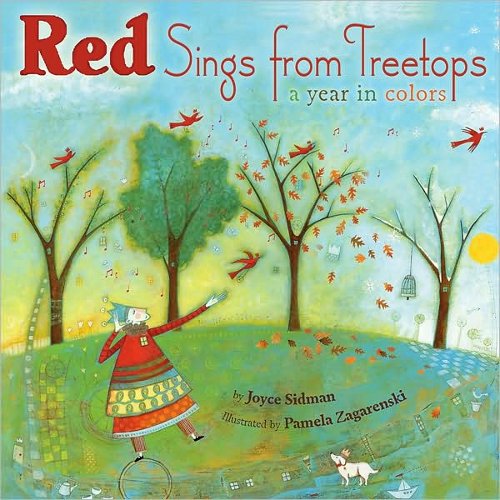
7-Imp: What was your road to publication?
Joyce: Long, like most people’s. Published a little adult poetry, had kids, rediscovered children’s lit, fell in love. Sent out reams of (rejected) picture books and novels until I happened on children’s poetry, which had more success. I published first with Millbrook Press, then moved to Houghton Mifflin, where I am exceedingly happy.
 7-Imp: Can you tell me a bit about your writing process/”craft”? Do you outline before you write or just let your muse lead you on and see where you end up?
7-Imp: Can you tell me a bit about your writing process/”craft”? Do you outline before you write or just let your muse lead you on and see where you end up?
Joyce: Poetry-writing for me seems to be 90% noodling around, dreaming, taking walks, pondering, turning words over in my head; and 10% actually putting pen to paper (or fingers to keys). I wander around in a haze of longing—wanting to write, wanting to tap into that great burning river of creativity—and then, boom! One day I see my way forward and begin writing. Usually it’s a sunny day.
Once the poem’s down on paper, I’m delighted to be revising, moving stuff around, reading to myself until everything is JUST RIGHT. This part can take months. But they are happy months.
7-Imp: If you were in charge of language arts, particularly poetry, instruction in the elementary grades, what changes would you make, if any, to the way language arts and poetry are taught in schools today?
Joyce: Hooo, boy. Teaching is hard. I could never do it full-time. Such a responsibility. I’d sprinkle a few more poems into classroom life, though. Start every day with a poem, maybe? (I know some teachers that do this.) Have the kids choose sometimes—let ‘em loose in the library in the 800’s. Every morning, have someone read a poem aloud, let the kids remark on what words they like, what images grab them, then move on to other subjects. A mind-clearer, as it were: a breath of fresh air.
7-Imp: How does your work in public schools (as a writer-in-residence) inform your writing?
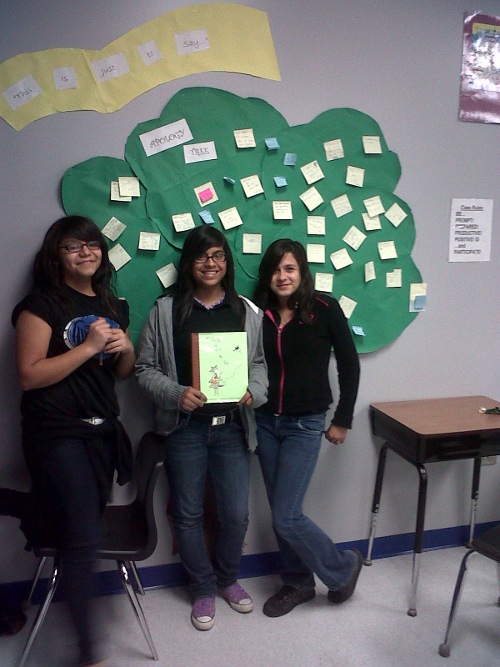
Joyce: It reacquaints me daily with the frank openness of children: they are so ready to believe, to celebrate, to love. How much, at bottom, they love words and the power words have to express what’s important to them. Also, sometimes (This Is Just to Say and Red Sings from Treetops) the work I do with them helps focus my own writing ideas.
7-Imp: I love the “Young Voices” portion of your web site. What do you learn from child poets who share their work with you?
Joyce: I learn that there is poetry inside of every single person on the face of the earth (and many dogs, as well). They hide it well, but you can always get to it in the end.
{Ed. Note: Pictured here is Joyce’s dog, Watson. This was posed so that Beckie could use it in her squirrel illustration for Ubiquitous, pictured below.}
7-Imp: As a book lover, it interests me: What books and/or authors had an especially significant impact upon you as an early reader?
Joyce: I often talk about The Bat-Poet by Randall Jarrell, but I also loved those action/adventure novels by people like Jane Langton and Joan Aiken and Elizabeth George Speare. Spunky heroines, bravery, and witty, transcendent writing.
7-Imp: What advice would you give to aspiring children’s poets?
Joyce: Write about what delights you. Write for yourself or for young people you know, not for some imaginary child with problems/concerns that match the market. Experiment! Play! But hold to your own standards of excellence.
7-Imp: Tell me and 7-Imp readers about some of your favorite poets (either contemporary or not-so) whom we have perhaps not heard of.
Joyce: There are so many I admire that I could not list them all here! I will tell you, though, that when I was starting out, Alice Schertle was the poet that jolted me awake. Such an incredibly fine wordsmith.
7-Imp: Are you working on any new projects that you can tell me about?
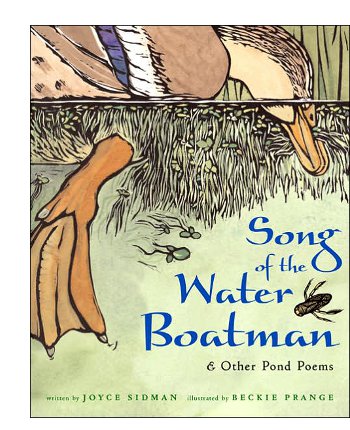 Joyce: Define “working.” I haven’t been actually writing much lately, due to teaching responsibilities, travel, and fallowness of brain. But I have a few things in production. My book coming out this fall is Dark Emperor and Other Poems of the Night, illustrated by a fellow Minnesotan, Rick Allen. I think of it as the last in the trio of “ecosystem books” that began with Song of the Water Boatman (pond) and continued with Butterfly Eyes (meadow). This one is about the forest at night—owls, moths, porcupines. Did you know a baby porcupine is called “porcupette”? How could you not write a poem about that?
Joyce: Define “working.” I haven’t been actually writing much lately, due to teaching responsibilities, travel, and fallowness of brain. But I have a few things in production. My book coming out this fall is Dark Emperor and Other Poems of the Night, illustrated by a fellow Minnesotan, Rick Allen. I think of it as the last in the trio of “ecosystem books” that began with Song of the Water Boatman (pond) and continued with Butterfly Eyes (meadow). This one is about the forest at night—owls, moths, porcupines. Did you know a baby porcupine is called “porcupette”? How could you not write a poem about that?
Also, Beth Krommes and I are working on a picture book that will be published in 2011 about spirals in nature. We were both separately doodling around with the idea last year when our editor nudged us gently together. Beth illustrated my book Butterfly Eyes, but this has been a much more collaborative project, and very fun.
7-Imp: What’s one thing that most people don’t know about you?
Joyce: Hmmmm. That I think about chocolate almost constantly???
7-Imp: If you could have three (living) authors/poets (or even illustrators)—whom you have not yet met—over for coffee or a glass of rich, red wine, whom would you choose?
Joyce: Yikes, another toughie. How about Laura Amy Schlitz (I’d love to hear her teaching stories), Francisco X. Alarcón (he seems suffused with joy), and Margaret Mahy (I love her work and she’d have that cool New Zealand accent).
7-Imp: Is there something you wish interviewers would ask you – but never do? Feel free to ask and respond here.
Joyce: I’ve already blabbed WAY too much about myself.

7-Imp: What is your favorite word?
Joyce: “Ubiquitous”!
7-Imp: What is your least favorite word?
Joyce: “Input.”
7-Imp: What turns you on creatively, spiritually or emotionally?
Joyce: Sunshine.
7-Imp: What turns you off?
Joyce: Concrete.
7-Imp: What is your favorite curse word? (optional)
Joyce: No creativity in this department.
7-Imp: What sound or noise do you love?
Joyce: The weird, whale-like noises that pond ice makes on a really cold day.
7-Imp: What sound or noise do you hate?
Joyce: Whining — human or canine.
7-Imp: What profession other than your own would you like to attempt?
Joyce: Bee-keeper.
7-Imp: What profession would you not like to do?
Joyce: Politician.
7-Imp: If Heaven exists, what would you like to hear God say when you arrive at the Pearly Gates?
Joyce: I have trouble imagining this particular scenario. However, I’d be thrilled to have my body contribute to a good, healthy thicket of oak trees.
Here’s your one-day-early Poetry Friday treat this week. I asked Joyce if she’d be willing to share here at 7-Imp a never-seen-before poem. Ever the good sport, she said yes. Lucky us. Enjoy. And remember that tomorrow’s Poetry Friday round-up will be hosted by Kate at Book Aunt.
“How to Find a Poem”
by Joyce SidmanWake with a dream-filled head.
Stumble out into the morning,
barely aware of how the sun
is laying down strips of silver
after three days’ rain,
of how the puddles
are singing with green.
Look up, startled
at the crackle of something large
moving through the underbrush.
Pulse jumping,
gaze into its beautiful face.
The wary doe’s body,
the soft flames of ears.As it bounds away,
listen to the rhythm
of your own heart’s disquiet.
Burn into memory
the white flag of its parting.
Before you return
to house and habit,
cast your eyes into the shadows
where others stand waiting
on delicate hooves.
Note: For more images from Ubiquitous, the book trailer can be viewed here.
UBIQUITOUS by Joyce Sidman, illustrated by Beckie Prange © 2010. Published by Houghton Mifflin, Boston, MA. Spreads used with permission of publisher. All other images used with permission of Joyce Sidman.
The spiffy and slightly sinister gentleman introducing the Pivot Questionnaire is Alfred, © 2009 Matt Phelan. Thanks to Matt, Alfred now lives at 7-Imp and is always waiting to throw the Pivot Questionnaire at folks.

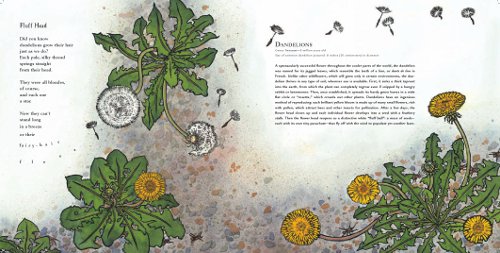

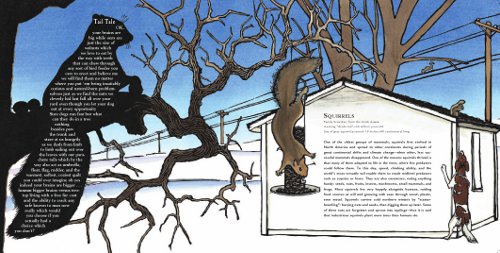

I can’t think of a more perfect way to begin Poetry Month than with this. Jules, Joyce: My pulse is jumping. Thank you.
What a gorgeous poem! Pulse jumping here, too. Love this interview, every single syllable. Happy Poetry Month!
Lovely! I must go and find a copy of UBIQUITOUS as soon as possible!
Thanks for this!
Love the look and what I can see of the words in these books. Favorite poem here (aside from “How to Find a Poem,” which inspires me to look there for a story, too) has to be the squirrel’s. What a voice that wiseacre has.
And oh, my, yes: I think “porcupette” just shot to the top of the list of new words learned in the last N months!
P.S. A healthy porcupette.
Thank you for starting my month off with a great interview by one of my total favorite poets. I. Love. her work. Love the new book.
Jules,
Joyce is a genius when it comes to writing poetry for children! I’ve loved every poetry book she has published. UBIQUITOS is a winner–another excellent collection of nature poems. Beckie’s illustrations are a perfect complement to Joyce’s text.
As Jone said–this was a great post to start off National Poetry Month.
I love that the poems aren’t watered-down for children – they really give the reader a lot of credit, and that’s something I would have appreciated as a child. Wonderful!
Thanks, you all.
Dana, YES. This is one of the many reasons Joyce rules. I sorta feel like my public service to the world via 7-Imp is to point out those books that don’t treat children like little idiots, since so many of them do — so much so that I feel like a broken record and am SURE I annoy readers, but I feel like I need to point it out every now and then.
John, thanks for the visual!
Wonderful interview… beautiful poem. Made my day,
Jules and Joyce, thanks for the great interview. Poetry and science well blended is one of my favorite things. I’ve just ordered Ubiquitous and can’t wait!
Not only is Joyce an inspiring wordsmith (what a way to start Poetry Month!) but she’s a lovely human being.
A sterling combination indeed!
April
http://www.teachingauthors.com
Wonderful interview! So inspiring. I especially loved hearing how various projects got started.
I have a gorgeous poem up from Ubiquitous today as the Poem of the Day for the first day of Poetry Month:
http://laurasalas.livejournal.com/208577.html
Another great interview! THANKS!
Someday I want to hear “The weird, whale-like noises that pond ice makes on a really cold day.”
Ah that was sweet. I am jazzed about what she says about teachers. Getting fired up over here!
Jules,
What a great interview! Joyce is one of my favorite poets, too.
Thanks so much!
Laura
all things poetry
[…] Joyce Sidman (April 1, 2010): “Poetry-writing for me seems to be 90% noodling around, dreaming, taking walks, pondering, […]
[…] spirals in nature are the focus of the latest picture book from poet and author Joyce Sidman, Swirl by Swirl: Spirals in Nature, to be released by Houghton Mifflin next month. The […]
[…] is bold . . .”– Spread from Joyce Sidman’s Swirl by Swirl: Spirals in Nature(Houghton Mifflin, October […]
[…] Interview on Seven Impossible Things before Breakfast […]
[…] Joyce Sidman, pictured here. We chatted yesterday morning at Kirkus about several things including taking risks, […]
[…] / hoped, or feared. …” Last week, I chatted here at Kirkus with author and poet Joyce Sidman about her newest poetry collection, What the Heart Knows: Chants, Charms & Blessings (Houghton […]
[…] check out this interview with the […]
[…] by Houghton Mifflin Harcourt and written by award-winning children’s book author and poet Joyce Sidman. The first, Dark Emperor & Other Poems of The Night, received a 2011 Newbery Honor. And I wrote […]
[…] Harcourt in the fall. And although I didn’t find too much about that book, I did find this interview, from 2010, with Julie Danielson at Seven Impossible Things Before […]
[…] …”(Click to enlarge spread) I’ve got a review over at BookPage of Joyce Sidman’s Before Morning (Houghton Mifflin Harcourt, October 2016), illustrated by Beth Krommes. That review […]